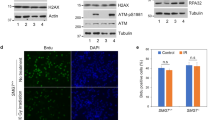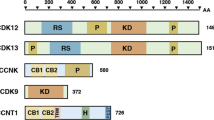Abstract
The transcription factor Miz1 is required for DNA-damage-induced cell-cycle arrest. We have now identified 14-3-3η as a gene that inhibits Miz1 function through interaction with its DNA binding domain. Binding of 14-3-3η to Miz1 depends on phosphorylation by Akt and regulates the recovery of cells from arrest after DNA damage. Miz1 has two functions in response to DNA damage: first, it is required for upregulation of a large group of genes, a function that is regulated by c-Myc, but not by 14-3-3η; second, Miz1 represses the expression of many genes in response to DNA damage in an Akt- and 14-3-3η-regulated manner.
This is a preview of subscription content, access via your institution
Access options
Subscribe to this journal
Receive 12 print issues and online access
$209.00 per year
only $17.42 per issue
Buy this article
- Purchase on Springer Link
- Instant access to full article PDF
Prices may be subject to local taxes which are calculated during checkout








Similar content being viewed by others
References
Bartek, J. & Lukas, J. Mammalian G1- and S-phase checkpoints in response to DNA damage. Curr. Opin. Cell Biol. 13, 738–747 (2001).
Macleod, K. F. et al. p53-dependent and independent expression of p21 during cell growth, differentiation, and DNA damage. Genes Dev. 9, 935–944 (1995).
Levens, D. L. Reconstructing MYC. Genes Dev. 17, 1071–1077 (2003).
Claassen, G. F. & Hann, S. R. A role for transcriptional repression of p21CIP1 by c-Myc in overcoming transforming growth factor b-induced cell-cycle arrest. Proc. Natl Acad. Sci. USA 97, 9498–9503 (2000).
Gartel, A. L. et al. Myc represses the p21WAF1/CIP1 promoter and interacts with Sp1/Sp3. Proc. Natl Acad. Sci. USA 98, 4510–4515 (2001).
Sheen, J. H. & Dickson, R. B. Overexpression of c-Myc alters G1/S arrest following ionizing radiation. Mol. Cell Biol. 22, 1819–1833 (2002).
Wu, S. et al. Myc represses differentiation-induced p21CIP1 expression via Miz1-dependent interaction with the p21 core promoter. Oncogene 22, 351–360 (2003).
Herold, S. et al. Negative regulation of the mammalian UV response by Myc through association with Miz1. Mol. Cell. 10, 509–521 (2002).
Seoane, J., Le, H. V. & Massague, J. Myc suppression of the p21Cip1 Cdk inhibitor influences the outcome of the p53 response to DNA damage. Nature 419, 729–734 (2002).
van de Wetering, M. et al. The β-catenin/TCF-4 complex imposes a crypt progenitor phenotype on colorectal cancer cells. Cell 111, 241–250 (2002).
Staller, P. et al. Repression of p15INK4b expression by Myc through association with Miz1. Nature Cell Biol. 3, 392–399 (2001).
Wanzel, M., Herold, S. & Eilers, M. Transcriptional repression by Myc. Trends Cell Biol. 13, 146–150 (2003).
Dyson, N., Howley, P. M., Munger, K. & Harlow, E. The human papilloma virus-16 E7 oncoprotein is able to bind to the retinoblastoma gene product. Science 243, 934–937 (1989).
Funk, J. O. et al. Inhibition of CDK activity and PCNA-dependent DNA replication by p21 is blocked by interaction with the HPV-16 E7 oncoprotein. Genes Dev. 11, 2090–2100 (1997).
Ichimura, T. et al. Molecular cloning of cDNA coding for brain-specific 14–3-3 protein, a protein kinase-dependent activator of tyrosine and tryptophan hydroxylases. Proc. Natl Acad. Sci. USA 85, 7084–7088 (1988).
Rittinger, K. et al. Structural analysis of 14–3-3 phosphopeptide complexes identifies a dual role for the nuclear export signal of 14–3-3 in ligand binding. Mol. Cell 4, 153–166 (1999).
Masuyama, N. et al. Akt inhibits the orphan nuclear receptor Nur77 and T-cell apoptosis. J. Biol. Chem. 276, 32799–32805 (2001).
Brunet, A. et al. 14–3-3 transits to the nucleus and participates in dynamic nucleocytoplasmic transport. J. Cell Biol. 156, 817–828 (2002).
Obata, T. et al. Peptide and protein library screening defines optimal substrate motifs for AKT/PKB. J. Biol. Chem. 275, 36108–36115 (2000).
Mayo, L. D. & Donner, D. B. A phosphatidylinositol 3-kinase/Akt pathway promotes translocation of Mdm2 from the cytoplasm to the nucleus. Proc. Natl Acad. Sci. USA 98, 11598–11603 (2001).
Zhou, B. P. et al. HER-2/neu induces p53 ubiquitination via Akt-mediated MDM2 phosphorylation. Nature Cell Biol. 3, 973–982 (2001).
Gottlieb, T. M., Leal, J. F., Seger, R., Taya, Y. & Oren, M. Cross-talk between Akt, p53 and Mdm2: possible implications for the regulation of apoptosis. Oncogene 21, 1299–1303 (2002).
Basu, S., Totty, N. F., Irwin, M. S., Sudol, M. & Downward, J. Akt phosphorylates the Yes-associated protein, YAP, to induce interaction with 14–3-3 and attenuation of p73-mediated apoptosis. Mol. Cell 11, 11–23 (2003).
Eapen, A. K., Henry, M. K., Quelle, D. E. & Quelle, F. W. DNA damage-induced G1 arrest in hematopoietic cells is overridden following phosphatidylinositol 3-kinase-dependent activation of cyclin-dependent kinase 2. Mol. Cell. Biol. 21, 6113–6121 (2001).
Brummelkamp, T. R. et al. TBX-3, the gene mutated in Ulnar-Mammary Syndrome, is a negative regulator of p19ARF and inhibits senescence. J. Biol. Chem. 277, 6567–6572 (2002).
Cheyette, B. N. et al. Dapper, a Dishevelled-associated antagonist of β-catenin and JNK signaling, is required for notochord formation. Dev Cell 2, 449–61 (2002).
Glaeser, M., Floetotto, T., Hanstein, B., Beckmann, M. W. & Niederacher, D. Gene amplification and expression of the steroid receptor coactivator SRC3 (AIB1) in sporadic breast and endometrial carcinomas. Horm. Metab. Res. 33, 121–126 (2001).
Teng, S. C. et al. Direct activation of HSP90A by c-MYC contributes to c-MYC induced transformation. J. Biol. Chem. 279, 14649–14655 (2004).
Itoh, K. et al. Human tumor rejection antigens MAGE. J. Biochem. (Tokyo) 119, 385–390 (1996).
Su, Y. A., Hutter, C. M., Trent, J. M. & Meltzer, P. S. Complete sequence analysis of a gene (OS-9) ubiquitously expressed in human tissues and amplified in sarcomas. Mol. Carcinog. 15, 270–275 (1996).
Mollinari, C. et al. The mammalian passenger protein TD-60 is an RCC1 family member with an essential role in prometaphase to metaphase progression. Dev. Cell 5, 295–307 (2003).
Player, A. et al. Identification of TDE2 gene and its expression in non-small cell lung cancer. Int. J. Cancer 107, 238–243 (2003).
el-Ghorr, A. A., Norval, M., Lappin, M. B. & Crosby, J. C. The effect of chronic low-dose UVB radiation on Langerhans cells, sunburn cells, urocanic acid isomers, contact hypersensitivity and serum immunoglobulins in mice. Photochem. Photobiol. 62, 326–332 (1995).
Peukert, K. et al. An alternative pathway for gene regulation by Myc. EMBO J. 16, 5672–5686 (1997).
Berns, K., Hijmans, E. M., Koh, E., Daley, G. Q. & Bernards, R. A genetic screen to identify genes that rescue the slow growth phenotype of c-myc null fibroblasts. Oncogene 19, 3330–3334 (2000).
Zeng, Y., Somasundaram, K. & el-Deiry, W. S. APC2 inhibits cancer cell growth and activates p21WAF1/CIP1 expression. Nature Genet. 15, 78–82 (1997).
Du, H., Roy, A. L., & Roeder, R. G. Human transcription factor USF stimulates transcription through the initiator elements of the HIV-1 and the Ad-ML promoters. EMBO J. 12, 501–551 (1993).
Bouchard, C. et al. Regulation of cyclin D2 gene expression by the Myc/Max/Mad network: Myc-dependent TRRAP recruitment and histone acetylation at the cyclin D2 promoter. Genes Dev. 15, 2042–2047 (2001).
Acknowledgements
This study was supported by grants from the Deutsche Forschungsgemeinschaft, The European Union and the Thyssen-Stiftung to M.E. We thank B. Jebavy and M. Neuhaus for expert technical assistance, M. Krause (MPI for Biochemistry, Munich) and B. Samans (Phillips University, Marburg) for performing and evaluating the microarray experiments, H. Hermeking and J. Daut for the gift of reagents and J. Downward (Cancer Research UK, London) for help with the analysis of phosphorylation sites on Miz1.
Author information
Authors and Affiliations
Corresponding author
Ethics declarations
Competing interests
The authors declare no competing financial interests.
Supplementary information
Supplementary Information
Fig S1, Fig S2, Table 1, Table 2 (PDF 420 kb)
Rights and permissions
About this article
Cite this article
Wanzel, M., Kleine-Kohlbrecher, D., Herold, S. et al. Akt and 14-3-3η regulate Miz1 to control cell-cycle arrest after DNA damage. Nat Cell Biol 7, 30–41 (2005). https://doi.org/10.1038/ncb1202
Received:
Accepted:
Published:
Issue Date:
DOI: https://doi.org/10.1038/ncb1202
This article is cited by
-
Protein phosphatase 1 regulatory subunit 15 A promotes translation initiation and induces G2M phase arrest during cuproptosis in cancers
Cell Death & Disease (2024)
-
Target gene-independent functions of MYC oncoproteins
Nature Reviews Molecular Cell Biology (2020)
-
Liver fluke infection and cholangiocarcinoma: a review
Parasitology Research (2017)
-
Syk-mediated tyrosine phosphorylation of mule promotes TNF-induced JNK activation and cell death
Oncogene (2016)
-
Regulation of CDKN2B expression by interaction of Arnt with Miz-1 - a basis for functional integration between the HIF and Myc gene regulatory pathways
Molecular Cancer (2014)



